This content originally appeared on Bits and Pieces - Medium and was authored by Ashan Fernando
This article explores nine prominent microfrontend integration patterns, highlighting their benefits, limitations, and practical considerations.
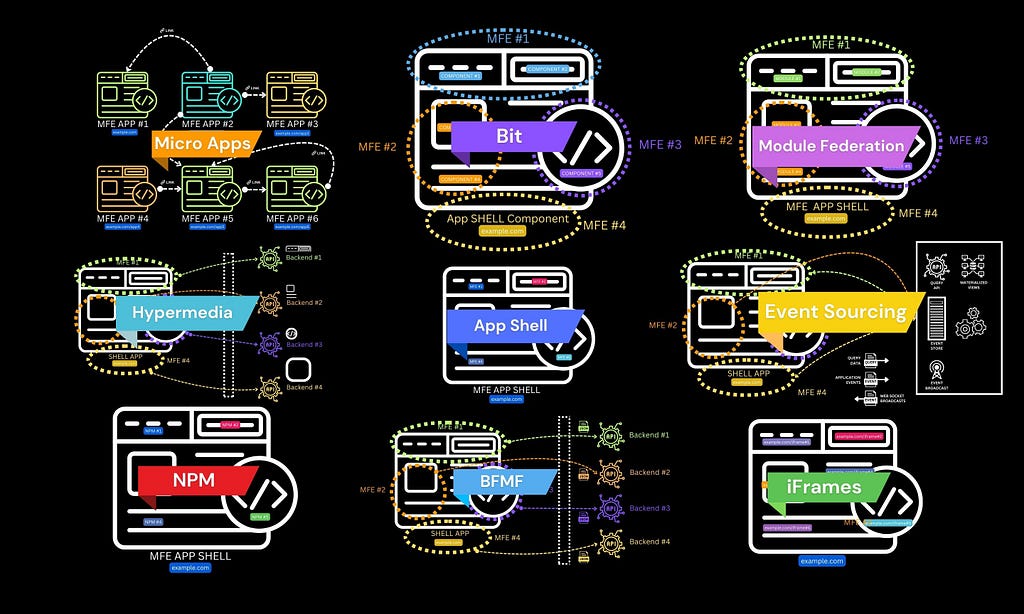
Microfrontend architecture is a modern way of thinking about application design. In this approach, independent frontend pieces are developed by separate teams and finally composed into a whole system. This architectural style has many advantages, such as allowing different teams to work on parts of an application in isolation and reducing the complexity that comes with large codebases.
However, when we break the application into Microfrontends, integrating these pieces needs to be properly handled. Factors such as dependencies, integration methods, nature of code reuse, and number of code repositories could impact the complexity of integrating these pieces.
This article will explore nine approaches to solving this problem, highlighting their strengths and weaknesses when using them in practice.
1. Micro Apps: Segmentation by Routes
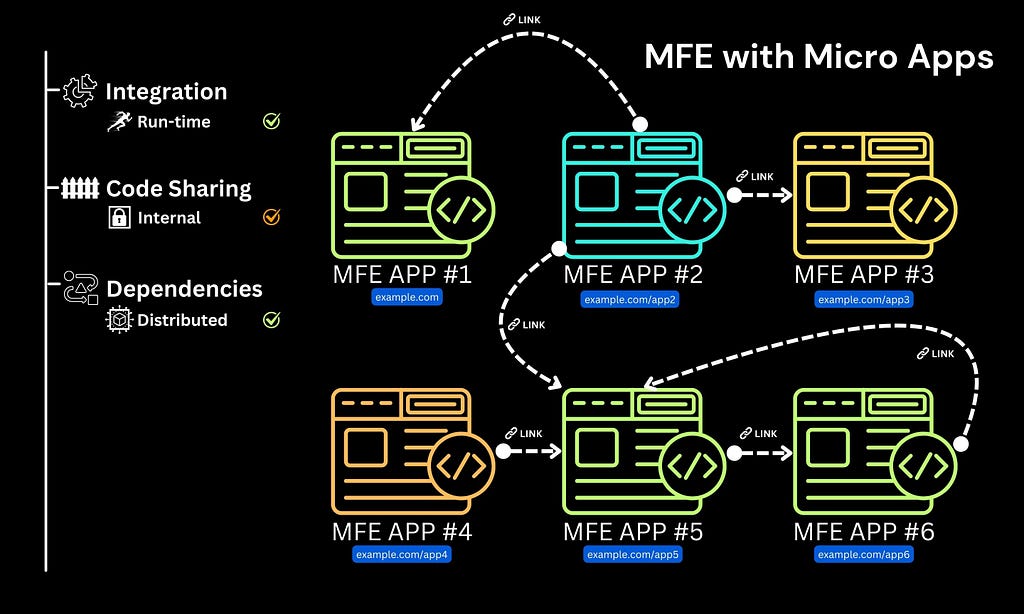
Micro apps pattern segment the application by routes, where each route loads a fully independent application, including its framework bundles.
One of the significant advantages of this pattern is the autonomy it provides. Teams can develop, deploy, and update their micro apps independently, leading to faster release cycles.
However, since each route loads a full application, including its framework, the loading time of each route could be increased. We must utilize browser caching, compression techniques (e.g. GZip and Brotly), and CDNs for common assets and JavaScript bundles to minimise this. Lazy-loading non-essential components and assets in the background or upon navigation can also help.
Besides, it requires clearly defining the domain boundaries and routes for each Microfrontend to prevent overlapping and ensure clear responsibility.
Benefits
- Full Autonomy for Development and Releases: Enables teams to develop and release features independently.
- Fault Isolation: Enhances overall reliability by isolating issues within individual micro apps.
- Minimal Dependencies Across Teams: Reduces the complexity of inter-team dependencies and integration conflicts.
Challenges
- Full Application Load for Each Route: This can lead to longer initial load times impacting user experience, particularly for users with slower connections.
- Importance of Caching and CDNs: Crucial for improving performance. It could increase the total cost of ownership.
- Breaking by Pages: Requires predetermined routes and clear ownership.
- Avoiding Overlapping Boundaries: It is essential to prevent conflicts and ensure smooth integration.
2. Microfrontends with iFrames: Strong Native Isolation
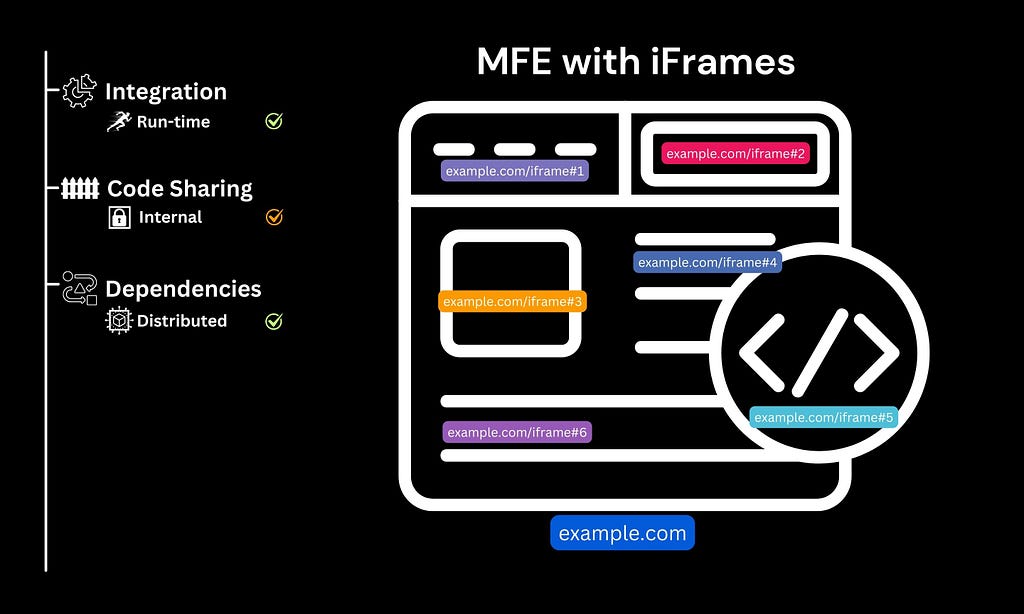
Microfrontends with iFrames create strong isolation by embedding each microfrontend in its own iframe inside a host application.
The main advantage of this approach is that each iframe operates independently, providing robust separation and fault isolation. If one iframe encounters an issue, the rest of the application remains unaffected, ensuring robust reliability.
This allows each team to develop, test, and deploy their microfrontend without affecting others. iFrames offer the flexibility to use any framework or stack, particularly useful for integrating diverse technologies. However, inter-iframe communication can be complex and requires careful consideration to maintain a cohesive user experience.
When implementing the iFrames pattern, minimising the number of iFrames is crucial to reduce performance overhead and ensure efficient memory usage. You can use inter-iframe communication mechanisms like postMessage to enable interactions between microfrontends. Additionally, implement caching strategies and utilize CDNs to minimize load times, similar to the approach used for micro apps.
Benefits
- Full Autonomy for Development and Releases: Each microfrontend operates within its own iframe, enabling teams to develop and release independently.
- Fault Isolation: If one iframe fails, the rest of the application remains functional, enhancing reliability.
- Minimal Dependencies Across Teams: Teams can work independently without the risk of interference from other microfrontends.
Challenges
- Inter-iframe Communication: Communication between iFrames can be complex, requiring additional frameworks or messaging systems.
- Performance Overhead: The overhead of multiple iFrames can impact performance, particularly regarding memory usage and load times.
- Responsiveness Issues: Making the application responsive can be a significant limitation with iFrames, as they are inherently less flexible in adapting to different screen sizes.
- Browser Security Restrictions: Certain browser security measures might prevent parts of the application from loading within an iframe.
- Declining Usage: Using iFrames is slowly diminishing, limiting their future viability.
3. Microfrontends with App Shell: A Centralized Platform for Integration
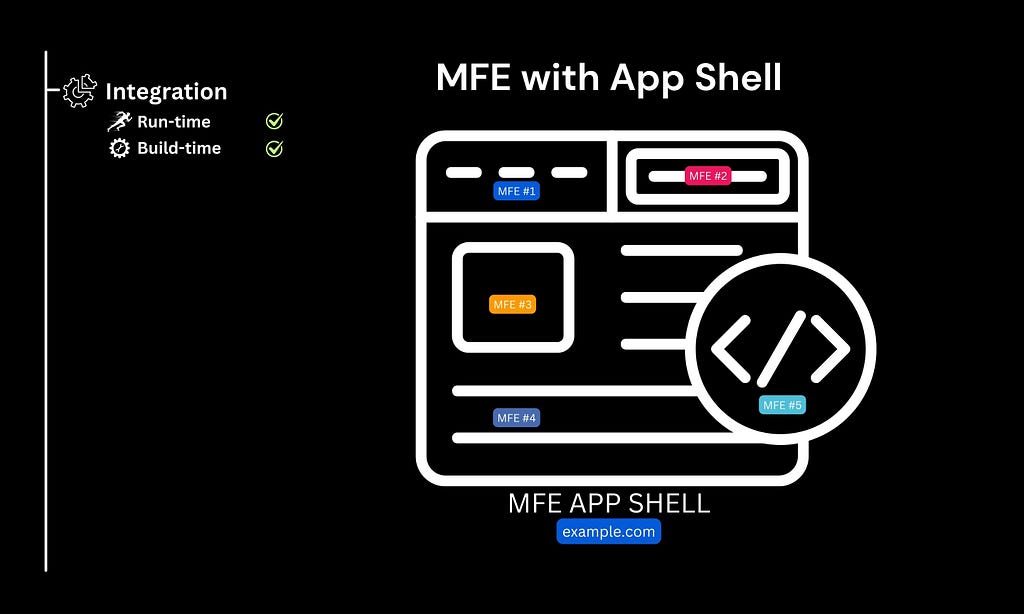
The App Shell pattern involves a central shell application that acts as a platform, loading various microfrontends.
The app shell pattern is fundemental for many other patterns and handles the cross-cutting concerns of the overal application.
The App Shell can be built using any framework or stack, providing flexibility in implementation. Each microfrontend typically needs to use a compatible technology and framework with the shell to ensure smooth integration.
The shell application loads individual microfrontends as needed, including components for navigation, authentication, and other shared services, promoting code reuse and consistency across the application.
Additionally, the App Shell facilitates handling various cross-cutting concerns, such as authentication, state management, and transitions between micro frontends, simplifying implementation and ensuring consistency.
Benefits
- Code Reuse and Shared Services: Centralizing shared components and services promotes code reuse and consistency.
- Cross-Cutting Concerns: Facilitates central handling of authentication, state management, and transitions between microfrontends, ensuring consistency and simplifying implementation.
Challenges
- Technology Compatibility: Each microfrontend needs to use a compatible technology and framework with the shell, which can limit flexibility.
- Potential Bottleneck: If the shell becomes too complex, it can become a single point of failure, reducing the independence of individual microfrontends.
- Loading Strategies: Sophisticated lazy-loading and caching strategies are needed for optimal user experience.
4. Microfrontends with Bit Components: Universal Composability
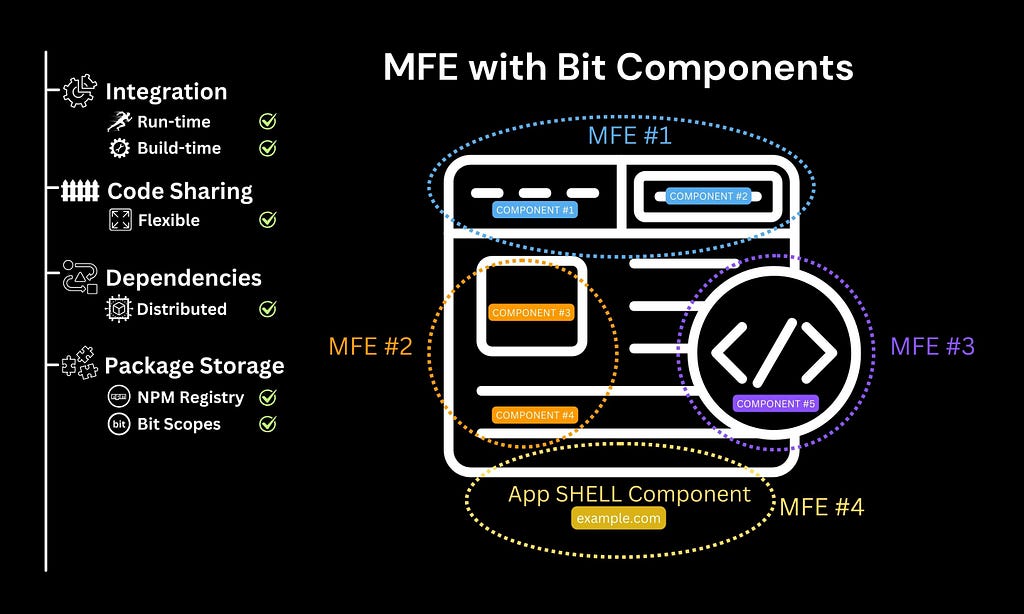
Microfrontends with Bit Components uses the Bit toolchain to create highly composable, reusable components that can be developed, tested, and deployed independently.
Bit Components allow for universal composability, enabling the creation and management of independent, reusable building blocks that support scalable microfrontend architectures.
Composable Software Architectures are Trending: Here’s Why
Each component can be developed and previewed locally using Bit development server and then exported to a centralized Bit cloud for storage and reuse. Each component in Bit functions like its own repository, allowing developers to pull down the components they want to modify into a workspace and contribute back. This is supported by Ripple CI, which builds only the affected dependencies based on the dependency graph, making the process highly efficient.
This approach supports both fine-grained and higher-order components, setting the foundation for scalable micro frontend architectures.
Bit components can be used in combination with various integration methods, including module federation, build-time integration, and bundling techniques.
When creating microfrontends, components are grouped into collections assigned to specific microfrontend teams. Bit encourages cross-team collaboration by promoting contributions to components, even if owned by different teams. It allows visualization of dependencies between micro frontends and components to understand the impact of changes.
Benefits
- High Composability: Supports the creation of universally composable components, from small UI elements to higher-order business logic components.
- Independent Development: Each component can be developed, tested, and deployed independently, enhancing team autonomy.
- Code Reuse: Promotes high code reuse by managing components in bit cloud, ensuring consistency and reducing duplication.
- Efficient Dependency Management: Bit handles dependencies at the component level. You can use peer dependencies to prevent any duplication.
- Flexibility in Integration: Can be used with module federation or build-time integration, providing flexibility in how components are integrated into the application.
- Cross-Team Collaboration: Facilitates contributions from different teams, even if the component is owned by another team.
- Dependency Visualization: Visualizes dependencies between microfrontends and components, aiding in understanding the impact of changes.
- Efficient CI: Ripple CI builds only the affected dependencies based on the dependency graph, improving efficiency.
Challenges
- Initial Setup: Setting up Bit Components within an existing architecture can require some initial effort, but predefined templates can help kickstart the project.
- Steep Learning Curve: Bit's concepts are novel and require a structured approach to learning. Teams must invest time in understanding the toolchain to use it effectively.
- Optimal Use of Peer Dependencies: Properly using peer dependencies is crucial to avoid bundling duplicated dependencies, ensuring efficient and streamlined builds.
Microfrontends with Bit Components pattern provides a robust and scalable solution for developing and integrating microfrontends. This approach ensures high composability, promotes cross-team collaboration and enhances overall application efficiency and maintainability.
5. Microfrontends with NPM: Modular Development with NPM Packages
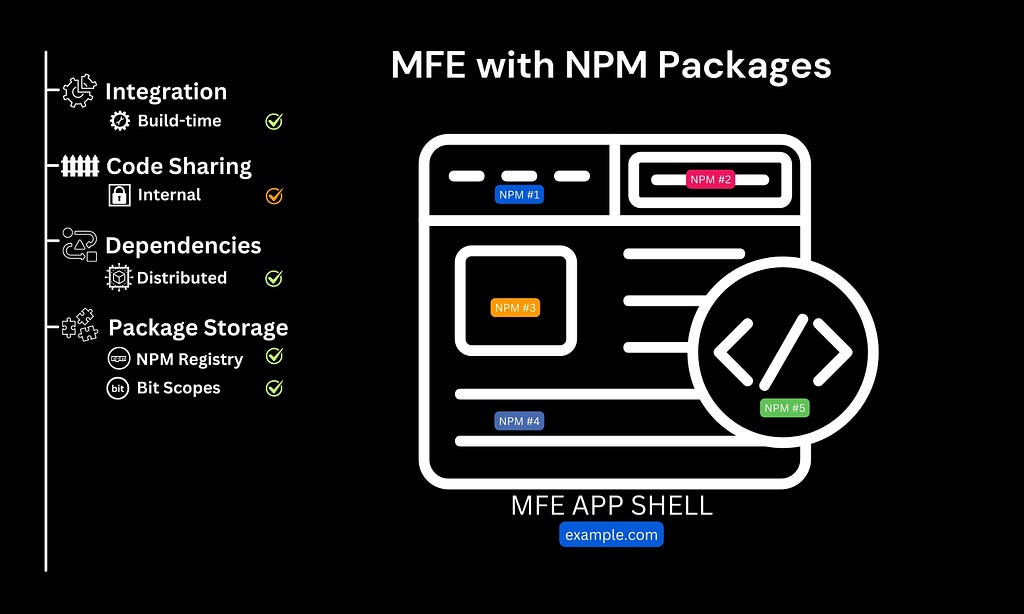
This pattern involves packaging each microfrontend as an NPM package, allowing teams to develop, test, and deploy independently. It can be used with an app shell that bundles the packages together.
However, each microfrontend must use a compatible framework and tech stack with the shell to ensure smooth integration and avoid conflicts.
Teams can work on their microfrontends independently and release updates as new NPM package versions.
Integration typically occurs at build time, helping to detect any integration issues upfront. You can also roll back easily to an old version if any errors occur.
Benefits
- Modular Development: Each microfrontend is an independent NPM package, allowing teams to develop, test, and deploy autonomously.
- Code Reuse and Shared Services: Can centralize shared components and services in NPM packages and promote code reuse and consistency.
- Easy Rollback: Versioning of NPM packages allows for easy rollback to previous versions if issues arise.
Challenges
- Technology Compatibility: Each microfrontend needs to use a compatible framework and tech stack with the shell, limiting flexibility in technology choices.
- Dependency Management: Managing dependencies across multiple NPM packages can be complex, requiring careful version control to prevent conflicts.
- Performance Impact: The need to rebuild the entire application can impact performance and delay the release process.
- Complex CI/CD Pipelines: Integrating and testing updates across multiple NPM packages can complicate CI/CD pipelines.
6. Module Federation: Dynamic Runtime Loading
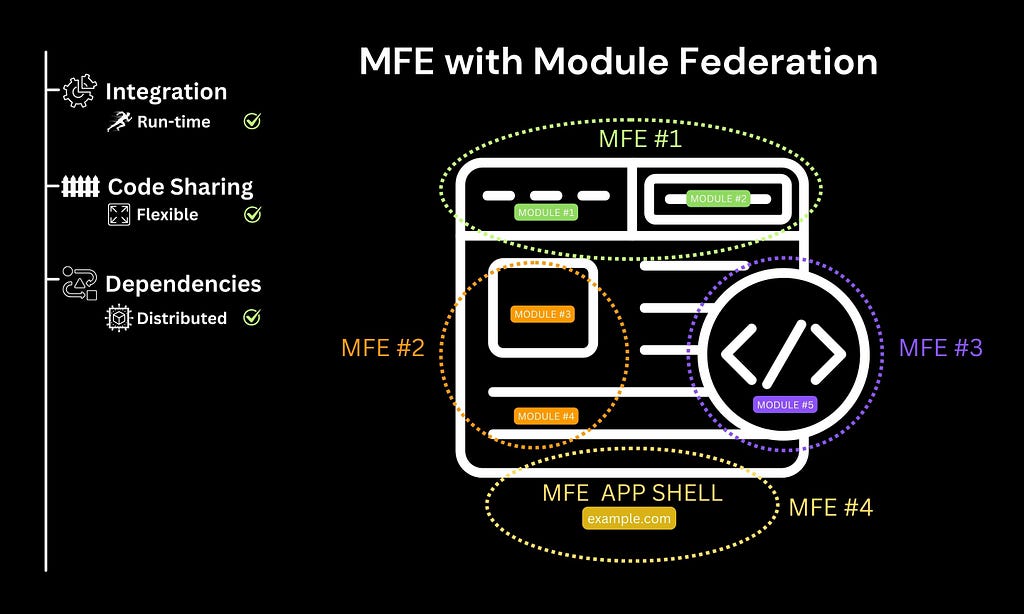
Module Federation allows microfrontends to be dynamically loaded at runtime, significantly reducing the need for build-time dependencies.
This pattern supports fine-grained modularity where each module can be independently developed and deployed. Using Webpack 5, teams can effectively manage dependencies and module loading.
The primary advantage of Module Federation is its flexibility in loading modules dynamically at runtime, allowing applications to be more responsive to changes. Each microfrontend can independently evolve and be updated, leading to faster release cycles and easier maintenance.
Benefits
- Runtime Flexibility: Modules can be dynamically loaded at runtime, reducing build-time dependencies and allowing for more flexible and responsive applications.
- Independent Development: Each microfrontend can be developed, tested, and deployed independently, enabling faster release cycles and easier maintenance.
- Code Sharing: High level of code sharing is possible, as shared modules can be loaded dynamically, reducing duplication and promoting consistency.
- Granularity: Supports fine-grained modularity, making it easier to manage and maintain individual components.
- Seamless Updates: Allows for seamless updates to individual modules without requiring a complete application rebuild.
Challenges
- Complex Setup: Implementing Module Federation requires a sophisticated setup and detailed integration contracts to manage dynamic loading and shared dependencies.
- Dependency Management: Ensuring compatibility between dynamically loaded modules and managing shared dependencies can be complex.
- Performance Impact: The overhead of dynamically loading modules at runtime can impact performance if not managed efficiently.
- Integration Complexity: Module Federation's dynamic nature can introduce integration complexity, requiring robust error handling and monitoring.
7. Backend for Microfrontend (BFMF)
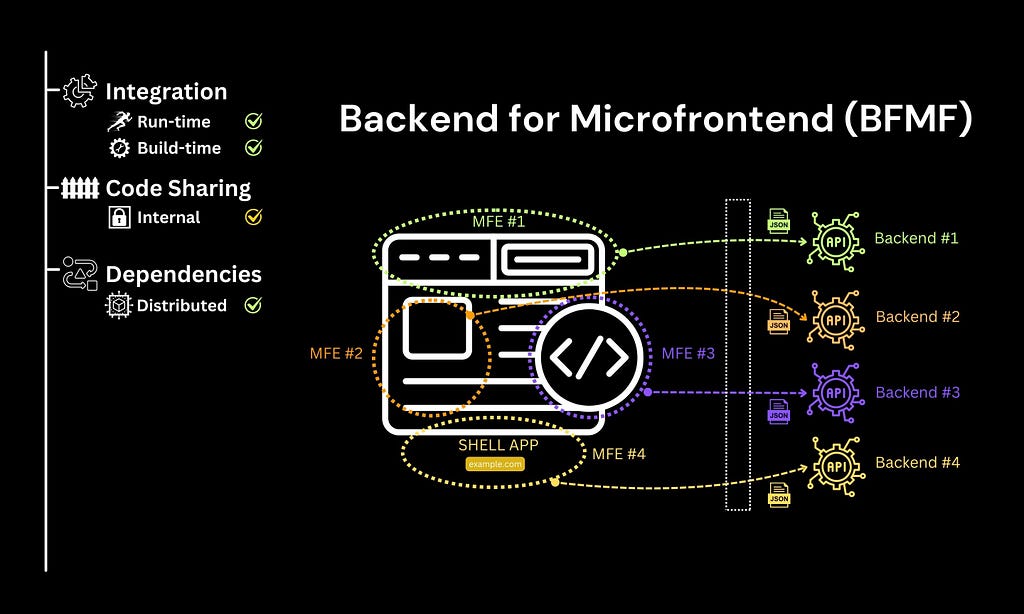
The BFMF pattern provides clear ownership, allowing teams to manage both the frontend and backend of their respective domains, leading to better-aligned priorities and more cohesive development efforts.
In the BFMF pattern, each microfrontend has its corresponding backend service.
Benefits
- Optimized Performance: Each backend service is tailored to the specific needs of its microfrontend, ensuring efficient data processing and reduced latency.
- Clear Ownership: Each team manages both the backend and the microfrontend, promoting accountability and cohesive development. Teams have full control over their domain, leading to better-aligned priorities and faster decision-making.
Challenges
- Consistency Management: Ensuring consistent data and business logic across multiple backends can be challenging.
- Resource Intensive: Maintaining multiple backends can be resource-intensive, requiring careful management of infrastructure and resources.
- Integration Overhead: Coordinating and integrating multiple backend services with their corresponding frontends can introduce overhead and the use of middleware services.
8. Event Sourcing-Based Microfrontends: The Responsive Orchestra
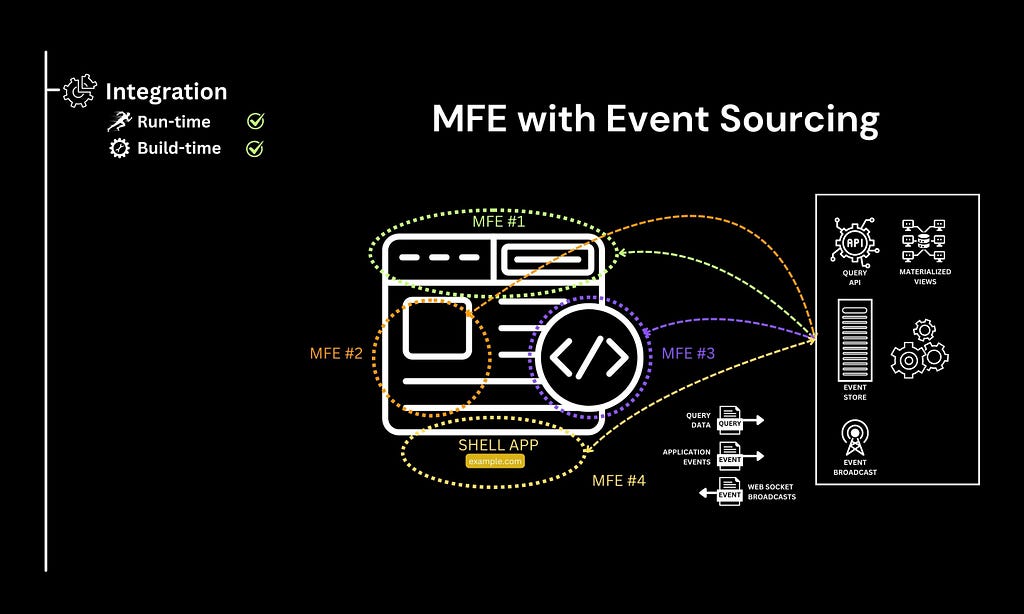
Event sourcing is a powerful pattern where state changes are logged as a series of immutable events, created and received by microfrontends for efficient communication and synchronization of state changes.
Event sourcing-based microfrontends operate by capturing state changes as immutable events, providing a dynamic and responsive user experience.
Each microfrontend interacts with the backend in a command-driven model, where user actions translate into events sent to the backend. The backend processes these events, updates the state, and broadcasts the resulting events back to the microfrontends. This event loop ensures synchronization without direct coupling, promoting scalability and resilience.
Event Sourcing pattern - Azure Architecture Center
One key advantage is maintaining a consistent state across multiple microfrontends, enhancing the user experience. However, implementing event sourcing requires robust infrastructure for event generation, storage, broadcasting, and efficient frontend event handling.
Benefits
- Real-Time Updates: Microfrontends receive events via WebSockets, allowing for real-time updates and immediate reactions to state changes.
- Consistent State: Ensures consistent state across multiple microfrontends, improving user experience and reducing discrepancies.
- Scalability and Decoupling: Each microfrontend can scale independently and react to events rather than relying on direct communication.
- Simple Backend Interaction: Frontends interact with the backend through a simple, command-driven model, translating user actions into events.
- Auditability: Every state change is logged as an event, providing a complete history of changes for debugging and auditing purposes.
- Resilience: Components can recover their state by replaying events, improving fault tolerance.
Challenges
- Complex Infrastructure: Implementing an efficient event store and managing event subscriptions can be complex and resource-intensive.
- Performance Overhead: Handling events and ensuring consistency can introduce performance overhead, requiring optimization.
- Consistency Management: Ensuring eventual consistency across microfrontends requires careful design and handling.
- Error Handling: Developing robust error-handling strategies for event processing and broadcasting is essential to maintain stability.
9. Hypermedia Pattern: The Dynamic Navigator
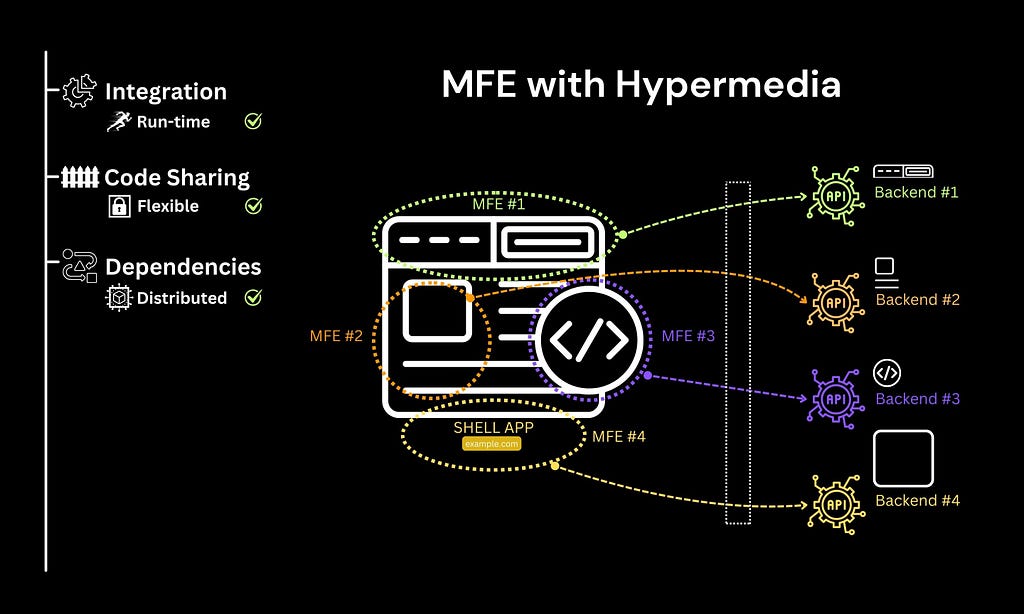
The Hypermedia pattern leverages hypermedia controls, such as links and forms, to navigate and interact with the application. Each microfrontend dynamically fetches its structure and available actions from a hypermedia API, creating a flexible and decoupled architecture.
The Hypermedia pattern provides a highly adaptable and flexible application structure by allowing each microfrontend to receive dynamic directions from a central hypermedia service.
In this pattern, each microfrontend operates autonomously, receiving directions from a central hypermedia service. The principles of Hypermedia as the Engine of Application State (HATEOAS) guide this pattern, with the backend providing hypermedia controls that instruct the frontends on interactions.
This decoupling allows for greater flexibility and easier updates, as navigation and interactions are driven by hypermedia responses rather than tightly coupled routes or structures.
Benefits
- High Flexibility: The application can evolve without changing the client code since the navigation and interactions are driven by hypermedia controls.
- Reduced Coupling: Microfrontends are decoupled from each other and from the backend logic, communicating through hypermedia links.
- Dynamic Structure: The application can adjust its structure and available actions based on the current state and hypermedia controls.
- Ease of Updates: Changes in the backend can be reflected in the frontend without requiring redeployment of the frontend code, facilitating smoother updates and maintenance.
Challenges
- Complex Implementation: Implementing hypermedia-driven microfrontends requires a sophisticated backend that can generate appropriate hypermedia responses.
- Performance Considerations: Frequent API calls to fetch hypermedia controls can introduce latency, impacting the user experience.
- Standardization: Ensuring consistent use of hypermedia standards across the application can be challenging, requiring strict adherence to HATEOAS principles.
- Error Handling: Developing robust error handling strategies for scenarios where hypermedia links or forms might not be correctly provided or followed.
Comparing Patterns
This comparison chart provides a high-level overview of each pattern's key aspects, helping you make informed decisions when selecting the best integration approach for your microfrontend architecture.
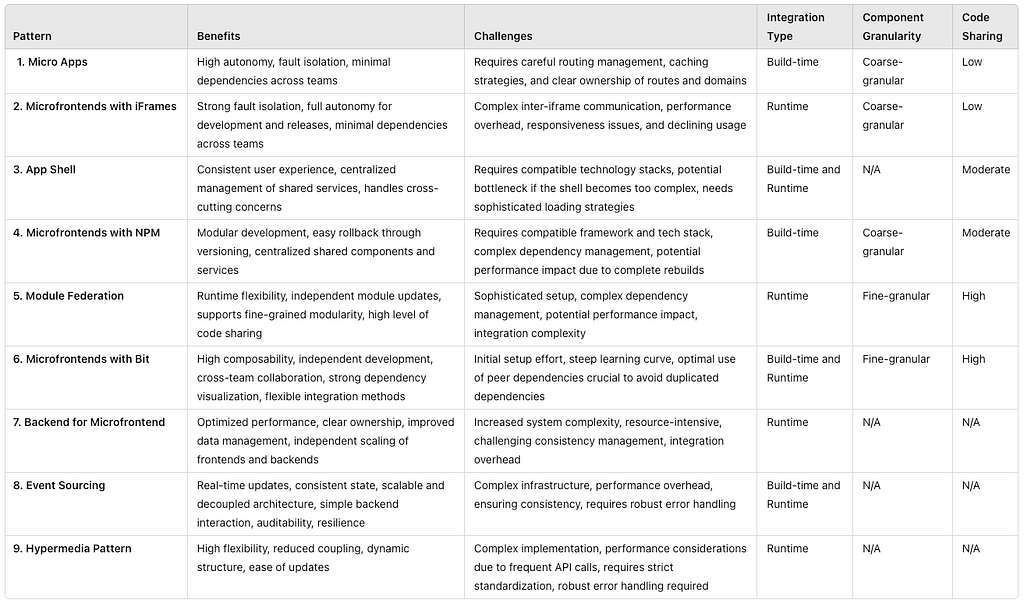
Conclusion
In this article, we have explored nine prominent patterns for integrating microfrontends, each offering unique benefits and challenges. As applications grow in complexity, breaking them down into independently developed and deployable microfrontends becomes increasingly attractive. These patterns provide the flexibility to choose the best approach based on specific project requirements, team structures, and long-term maintainability goals.
Key Takeaways:
- Micro Apps: Offers high autonomy and fault isolation but requires careful routing management and caching strategies to optimize performance.
- Microfrontends with iFrames: Provides strong isolation and ease of implementation but can have performance overhead and challenges in maintaining a cohesive user experience.
- App Shell: Ensures a consistent user experience and centralized management of shared services but requires compatible technology stacks and optimized performance strategies.
- Microfrontends with NPM: Promotes modular development and easy rollback through versioning but necessitates complete rebuilds for updates and careful dependency management.
- Module Federation: Facilitates runtime flexibility and independent module updates, though it demands a sophisticated setup and robust dependency management.
- Microfrontends with Bit Components: Enhances universal composability and cross-team collaboration, leveraging both build-time and runtime integration, with strong dependency visualization.
- Backend for Microfrontend (BFMF): Provides optimized performance and clear ownership by aligning backend services with microfrontends, though it increases overall system complexity and resource requirements.
- Event Sourcing-Based Microfrontends: Ensures real-time updates and consistent state through event-driven architecture but requires a robust event store and efficient event handling mechanisms.
- Hypermedia Pattern: Offers high flexibility and reduced coupling with dynamic client adaptation driven by hypermedia controls but involves complex implementation and performance considerations.
Combining Patterns:
It’s also possible to combine these patterns to leverage their strengths. For example, Bit Components can be used with Module Federation to achieve both high composability and runtime flexibility. By combining patterns, teams can tailor their integration approach to meet your project needs better and maximize the benefits of microfrontend architecture.
Choosing the Right Pattern:
Selecting the appropriate microfrontend integration pattern depends on your application’s specific requirements, team structure, and long-term maintainability goals. Each pattern offers unique advantages and comes with its own set of challenges. By understanding these nuances and comparing them across various factors, architects and developers can make informed decisions that best suit their needs.
In summary, microfrontend integration is crucial for building modern applications that can adapt to changing business needs. Leveraging the right pattern helps overcome architectural challenges and delivers superior user experiences. Staying informed about these patterns and their evolving implementations is essential for success in the dynamic landscape of frontend development.
Thank you for reading! Cheers!
Learn More
- Micro Frontends: A Practical Step-by-Step Guide
- React Microfrontend Authentication: Step by Step Guide
- Building a Host Application for Your Micro Frontends
- Integrating Micro Frontends via Shared Types
Mastering Microfrontends: 9 Patterns Every Developer Should Know was originally published in Bits and Pieces on Medium, where people are continuing the conversation by highlighting and responding to this story.
This content originally appeared on Bits and Pieces - Medium and was authored by Ashan Fernando
Ashan Fernando | Sciencx (2024-07-18T16:31:22+00:00) Mastering Microfrontends: 9 Patterns Every Developer Should Know. Retrieved from https://www.scien.cx/2024/07/18/mastering-microfrontends-9-patterns-every-developer-should-know/
Please log in to upload a file.
There are no updates yet.
Click the Upload button above to add an update.
